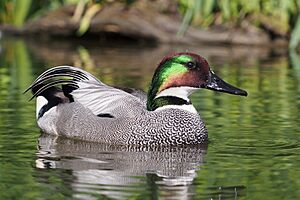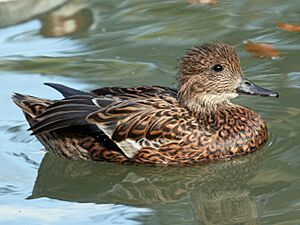Falcated duck facts for kids
Quick facts for kids Falcated duck |
|
|---|---|
 |
|
 |
|
| Male above, female below | |
| Conservation status | |
| Scientific classification | |
| Genus: |
Mareca
|
| Species: |
falcata
|
| Synonyms | |
|
Anas falcata Georgi, 1775 |
|
The falcated duck (Mareca falcata) is a type of dabbling duck. It's about the same size as a gadwall duck. You can find these ducks in eastern Asia, from Siberia and Mongolia to northern Japan. In winter, they fly south to places like India.
Contents
About the Falcated Duck
What Kind of Duck Is It?
The falcated duck is closely related to the gadwall. It is also related to the wigeons. Scientists used to call this duck Anas falcata. Now, they usually place it in the genus Mareca. This change helps scientists better understand how different duck species are related.
What Do They Look Like?
Falcated ducks are usually between 46 and 53 centimeters (about 18-21 inches) long. They weigh from 422 to 770 grams (about 15-27 ounces). Males are usually a bit heavier than females. Their wings can spread out from 79 to 91 centimeters (about 31-36 inches).
The male falcated duck is very easy to spot. Most of his body is a mix of grey and white. He has long, curved feathers on his back. These feathers look like sickles, which is how the duck got its name. His head is dark green with a white throat. He also has a dark green collar and a shiny bronze cap on his head.
Female falcated ducks are dark brown. They look a lot like female wigeons. A good way to tell them apart is by their long, grey bill. Young ducks look similar to the females.
These ducks are usually quiet. But during breeding season, the males make a shrill whistling sound. Females make a hoarse quack.
Where Do They Live?
Falcated ducks breed in eastern Asia. They nest in places like eastern Russia, northern China, and northern Japan. They are strong migratory birds. This means they fly long distances for winter. They spend winter in many parts of Southeast Asia. This includes northern India, Bangladesh, Myanmar, Laos, Vietnam, and southern China.
Outside of breeding season, these ducks like to gather in large groups. They prefer lowland wetlands, like wet meadows or lakes. They usually find their food by dabbling in the water or grazing on plants.
Scientists estimate there are about 89,000 falcated ducks in the world. This number is higher than earlier guesses. Some falcated ducks have been seen far from their usual homes. However, these might be ducks that escaped from zoos or private collections.
What Do They Eat?
Falcated ducks mostly eat plants. They also eat small insects and other tiny creatures. They find food near the water. This includes things like larvae, small crustaceans, and snails. They also eat plant parts like leaves, seeds, grains, and nuts. Many people think falcated ducks help spread seeds. They do this by eating seeds and then flying to new places.
Like all animals, ducks can carry tiny germs. These germs can sometimes be passed to other animals.
How Do They Raise Their Young?
Falcated ducks usually lay 6 to 10 eggs. They lay their eggs in late May. They build their nests on the ground. They hide them in thick grasses, bushes, or dead wood. Nests are usually close to water. Sometimes, they are found a bit further away, like 80 meters (about 260 feet) from the water.
The eggs are white with a pinkish-yellow tint. Only the female duck sits on the eggs. She keeps them warm for about 24 to 25 days. The male duck leaves the female during this time.
Falcated ducks have special ways of attracting a mate. Males do a "grunt-whistle" and other moves. Females make special calls and preen their feathers. During mating season, a male and female duck will stay together. They form a pair for that season.
Duck Hybrids
Sometimes, different types of ducks can have babies together. These babies are called hybrids. Scientists have seen hybrids of falcated ducks and Eurasian wigeons in Japan. These hybrid ducks look like a mix of both parents. But they often look more like the falcated duck.
These hybrid ducks sometimes try to mate with other ducks. It's not always clear if they can have babies themselves. Studying these hybrids helps scientists learn more about how ducks reproduce.
Protecting These Ducks
What Threats Do They Face?
One big danger for falcated ducks is hunting. People hunt them for food and their feathers. Another problem is that their homes are disappearing. Wetlands, where they live, are often drained for human use.
The falcated duck is not considered endangered anymore. But it is still listed as "near threatened" by the IUCN. The IUCN is a group that tracks how many animals are at risk.
How Do People Affect Them?
Falcated ducks need coastal wetlands to survive. Some important wetland areas in China are used by falcated ducks during their migration. But cities are growing, and this can disturb these important areas.
For example, a project in China created artificial wetlands. This was done to help migratory birds. While some birds use these new wetlands, they are not as good as natural ones yet. More research is needed to make them better homes for ducks.
Also, some ponds are drained for fishing. This happens during the Chinese spring festival. When the ponds are dry, ducks can't use them. If the water isn't put back soon enough, it can harm the ducks.
What Is Being Done to Help?
The falcated duck is protected by laws like the Migratory Bird Treaty Act. Their population seems to be stable and even growing in some areas. You can find falcated ducks in many wildlife preserves, national parks, and zoos.
Scientists and conservationists are working to protect these ducks. They want to keep watching the duck populations. They also want to ask for rules about hunting. It's important to teach people about why waterfowl are important. Conservationists are also looking for other jobs for hunters. Finally, they hope to make existing nature reserves even better for the falcated duck.
Images for kids
-
A falcated duck, a rare visitor from Asia, that arrived at California's Colusa National Wildlife Refuge in December 2011





